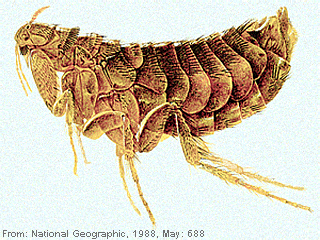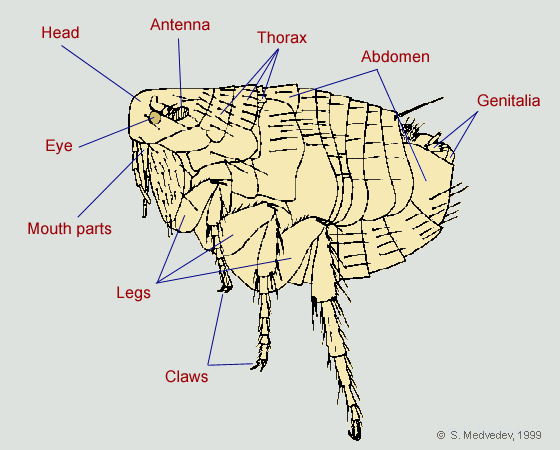| Introduction |
 Fleas (order Siphonaptera) are one of the major groups of blood-sucking insects. They
belong to holometabolic insects. Holometabolism is a feature characteristic also of
Diptera, Lepidoptera, etc. Fleas form a separate well differentiated order, although
phylogenetically they are regarded to be closer to Diptera and Mecoptera. At present
approximately 2000 species and subspecies of fleas are known.
Fleas (order Siphonaptera) are one of the major groups of blood-sucking insects. They
belong to holometabolic insects. Holometabolism is a feature characteristic also of
Diptera, Lepidoptera, etc. Fleas form a separate well differentiated order, although
phylogenetically they are regarded to be closer to Diptera and Mecoptera. At present
approximately 2000 species and subspecies of fleas are known.
Adult fleas are obligatory hematophages parasitising warm-blooded animals - mammals and birds. Wormlike free-living legless flea larva develops in the litter of host's nest. The majority of fleas are periodically attacking burrow or nest-dwelling parasites, capable of long time to present in hostís fur, unlike free blood-suckers, such as, for example, Diptera or some bugs.
 Fleas are secondarily wingless insects.
Their body is flattened on the sides and is represented by 3 major parts, or tagma: head,
thorax, abdomen. Thorax of fleas is provided with three pairs of legs, the hind legs are
the longest. The shape of the head, the flat body shape and prehensile claws of legs help
it to move easily through hostís wool. Length of jump some flea species attains 32 cm,
average body length being from 1 to 5 mm. Colour of flea body may be light yellow,
yellowish black, brown black or jet-black.
Fleas are secondarily wingless insects.
Their body is flattened on the sides and is represented by 3 major parts, or tagma: head,
thorax, abdomen. Thorax of fleas is provided with three pairs of legs, the hind legs are
the longest. The shape of the head, the flat body shape and prehensile claws of legs help
it to move easily through hostís wool. Length of jump some flea species attains 32 cm,
average body length being from 1 to 5 mm. Colour of flea body may be light yellow,
yellowish black, brown black or jet-black.
Fleas are widely spread on all continents, Antarctica included. They occur on hosts and in their nests in all types of habitats from the equatorial deserts and tropical rainforests to the northernmost regions of Arctic tundra. In general in Eurasia as in other continents the largest number of species and genera of fleas occur in several regions with temperate subtropical climate and predominance of mountain landscapes. The most numerous flea fauna is known for Eurasia.
Representatives of the order are known as vectors of plague microbes, murine typhus rickettsiae and some jther pathogens. The great practical significance of fleas determines the necessity to study their fauna for the entire world and separate regions and to elaborate of systematics of the order. Epidemiological significance of fleas determined the great interest of specialists from different countries of the world. The world fauna of this relatively small insect order had been mainly studied by the 1970s-1980s. However classification and phylogeny of the order has not been elaborated completely. No extensive reviews on the fauna of the former Soviet Union and the USA have been published yet.
The elaboration of the natural system of the order, however, is complicated because all fleas are highly specialised parasites. Only a few specimens of fossil fleas from Eocene Baltic and Moicen Dominican amber are currently known. In their characteristics they are nearly identical to the recent forms.